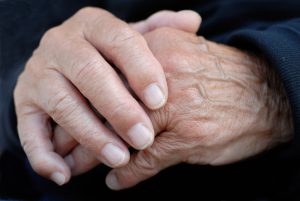Arthritis and Fishing
Reposted from Commercial Fisheries News, November 2022
 by Brie Weisman, OTR/L with Maine AgrAbility
by Brie Weisman, OTR/L with Maine AgrAbility
It’s early morning. A cold, damp feel is in the air. You’re dressed for the elements, but a day of work awaits, maybe you’re hauling lobster traps, oyster bags, or line catching tuna. You already notice the soreness in your hands, the bit of redness and swelling. You have difficulty making a fist.
These are most likely symptoms of arthritis. The CDC says that about one in four adults and fully half of all people over 65 suffer from arthritis.
Like machinery, our joints need lubrication and cushioning. We often begin to lose this as we age, and working our own unprotected joints can be just as problematic as operating ungreased machinery. Arthritis causes pain, inflammation, and limited range of motion. Osteoarthritis is the most common form typically affecting hands, hips, knees, feet and lower back and is the most treatable.
Risk factors for arthritis include:
· Family history
· Age
· Previous joint injury
· Obesity
There is no cure for arthritis; fortunately, there are natural, non-invasive methods that may greatly reduce symptoms:
- Relaxation therapies–mindful breathing, yoga, meditation, listening to music, guided imagery, simply getting out in nature–are all proven techniques for reducing pain.
- Acupuncture. This 3000 year old practice has found validation for arthritis treatment from so many studies that insurance companies cover it.
- Heat and cold. Applying heating pads to aching joints, taking hot baths or showers, or immersing painful joints in warm paraffin wax, can offer temporary relief of pain. Use heating pads for no more than 20 minutes at a time. Applying ice/cold packs to sore muscles can relieve pain and inflammation after strenuous work or exercise.
- Massage can offer relief from pain and stiffness. Make sure your massage therapist or masseuse knows where your arthritis affects you.
- Cognitive behavioral therapy (CBT) has been recognized as the most widely used psychotherapeutic treatment for adults with chronic pain. CBT employs talk therapy and behavior modification to help identify and break cycles of harmful or self-limiting thoughts and actions.
These conservative treatments are often enough for effective management of arthritis. For more severe cases, your physician may recommend medications and more invasive treatments:
- Therapeutic injections: cortisone shots may help temporarily relieve pain and inflammation.
- Fusion: A procedure that permanently fused two or more bones. This reduces pain greatly at the loss of the joint’s mobility.
- Joint replacement: Damaged, arthritic joints can be replaced with artificial joints, increasing joint function and movement while reducing or eliminating pain.
While you are on the boat, you can make simple changes to your routine to lessen joint pain through adaptive techniques and through the use of adaptive equipment. To learn more about implementing these changes contact Maine AgrAbility program.
Fishermen do have one advantage in staving off arthritis: an active lifestyle is the best way to maintain a healthy body. “Move it or lose it” applies to joint mobility and comfort. However, long, static boat rides, awkward work positions, repetitive motions, and cold or damp weather can all lead to or exacerbate arthritis. As with so many things, addressing the earliest signs of arthritis and sticking with a treatment will likely give the best results and head off greater suffering and hardship. And, as many of these treatments have other benefits beyond treating arthritis and are free or inexpensive, it is hard to argue against giving them a try.
